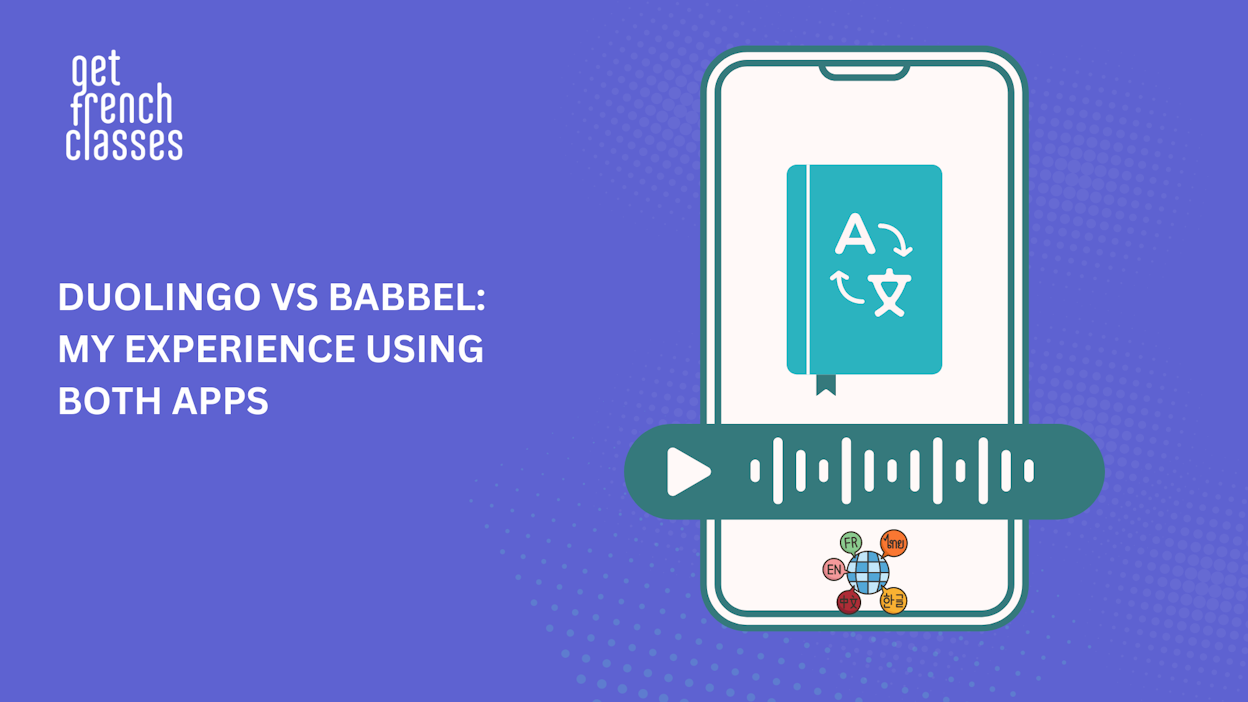As the founder of a language school, I often encounter potential learners who are genuinely interested in our programs but lack the budget to enroll.
In these situations, I always refrain from recommending language learning apps as an alternative solution.
The reason is simple: I don't believe language apps truly help anyone progress from being a complete beginner to achieving a significant level of proficiency.
In a previous review, I discussed how Duolingo incentivizes the wrong behaviors, prioritizing unnecessary achievements over genuine language mastery. I also mentioned that if learners are limited to choosing between apps, Rosetta Stone should be the preferred option.
Today, I'll be reviewing two popular language learning platforms: Duolingo and Babbel
While I personally wouldn't use either of these apps for my own language-learning journey, I recognize that many people have requested a comparison between the two.
In this post, I'll provide an honest and thorough analysis of both Duolingo and Babbel, highlighting their strengths, weaknesses, and overall effectiveness in helping learners achieve their language goals.
By the end of this review, you'll have a clearer understanding of how these apps stack up against each other and whether they're worth considering as part of your language learning toolkit.
Babbel vs Duolingo: Who wins a fight? — TL/DR
In the battle of Babbel vs. Duolingo, there's no clear winner. Both language-learning apps have significant strengths and weaknesses.
Babbel offers a more structured, grammar-focused approach with content created by professional linguists, while Duolingo excels in gamification and adaptive learning technology.
However, neither app is likely to take you to full fluency on its own. Here is a quick overview of how both apps operate.
| Feature | Babbel | Duolingo |
|---|---|---|
| Cost | Paid subscription | Free, with an optional paid subscription |
| Content quality | Created by linguists and native speakers | User-generated translations |
| Learning approach | Grammar-focused, traditional methods | Gamification and adaptive learning |
| Speaking practice | Limited | Speech recognition, but no conversation practice |
| Effectiveness | Best for beginners; may plateau at basic level | Effective for basic vocabulary, limited for fluency |
| Languages offered | 14 languages | 33 languages |
| Personalization | Limited | Adaptive learning, but no human feedback |
| Cultural context | Some, but limited | Minimal |
| User experience | Structured lessons, less engaging | Highly engaging, but less structured |
| Technology | Speech recognition, review sessions | AI-powered feedback, adaptive difficulty |
Ultimately, the choice between Babbel and Duolingo depends on your learning style, budget, and personal goals.
If you're serious about mastering a language like French, though, you may want to consider a more comprehensive and immersive language learning program like Get French Classes.
Should you even compare Duolingo and Babbel? If so, what elements should you compare them against?
At first glance, it might seem natural to want to compare Duolingo and Babbel. After all, they're both popular language-learning apps, and you're probably wondering which one offers the best value for your time and money.
Duolingo is known for being free (although their premium subscription, Duolingo Plus, costs $83.88/year), while Babbel is a paid language learning app that currently offers a lifetime subscription for $299.5, which includes access to all 13 languages.
For budget-conscious learners, the price difference alone makes Duolingo seem like the obvious choice.
However, before making a decision based solely on price, you need to look closely at what each app actually offers in terms of learning experience and outcomes.
As the adage goes, you often get what you pay for – and this certainly applies when it comes to language learning apps.
In reality, comparing Babbel and Duolingo is a bit like comparing apples and oranges. While they're both fruits (i.e., language apps), they have very different approaches, content, and target audiences.
The only real similarity is that neither is particularly effective at taking you to a high level of fluency.
I don't believe you should have to choose between Babbel and Duolingo at all, as neither is a great investment for serious learners. There are far better resources available that provide more comprehensive, effective, and rewarding learning experiences.
That being said, if you did want to compare Duolingo and Babbel, here are some key criteria to consider:
-
Quality of content : Is the learning material engaging, relevant, and well-structured? Does it provide clear explanations and authentic examples of the language in use?
-
Language-learning technology : How effective and user-friendly are the apps' unique features, such as Duolingo's AI-powered feedback or Babbel's speech recognition and personalized review sessions?
-
Cost : While it's important to consider your budget, the cheapest option isn't always the best value in the long run. A more expensive but higher-quality resource may lead to better results and be more motivating.
-
Pedagogical approach : What is the learning philosophy behind each app? Is it based on sound language acquisition principles, or is it more focused on superficial gamification and achieving a "quick fix"?
-
Effectiveness : Most importantly, will the app actually help you achieve your language learning goals? Can it take you to genuine fluency, or will you plateau at a beginner level?
In the following sections, we'll take a closer look at how Duolingo and Babbel stack up against these criteria.
Why you shouldn’t even consider Duolingo
If you're serious about learning a language and want to achieve fluency, Duolingo should not be your first choice.
While it might be tempting to use the free app, especially when compared to paid options like Babbel, Duolingo's approach to language learning is fundamentally flawed and will likely leave you frustrated and unprepared for real-world communication.

Duolingo's gamified style might work well for casual language learners or children who are exploring a language without any pressure to become fluent.
However, if you have a genuine need or desire to master a language for work, travel, or personal growth, Duolingo will fail you miserably.
Here's why:
Lack of grammar explanations and context
One of the biggest issues with Duolingo is its lack of context and explanations when it comes to grammar and vocabulary.
Context is crucial in language learning, as the same word or phrase can have vastly different meanings depending on the situation.
For example, in French, saying "Qu'est-ce que t'es con" to a close friend is a lighthearted joke, but saying "T'es con" to a stranger would be incredibly rude.
Duolingo fails to teach these nuances and cultural intricacies, leaving you without the necessary context to use the language appropriately.
Similarly, in Japanese, there are different levels of formality and politeness that are essential to master for effective communication. However, Duolingo rarely touches on these cultural aspects, instead focusing on isolated sentences and phrases .
As a result, you may be able to recite grammar points but struggle to navigate real conversations without inadvertently causing offense.
Irrelevant and bizarre sentence examples
Another major flaw in Duolingo's approach is its reliance on nonsensical and irrelevant sentence examples.
Users are often forced to memorize phrases like "The cat is a unicorn" or "I am an apple," which have no practical use in real-life situations.
While these bizarre sentences might help expand your vocabulary in a superficial sense, they don't contribute to your ability to communicate effectively.
No wonder language learners often complain that after months of using Duolingo, they can understand parts of the language but struggle to express themselves when it counts.
This is because Duolingo places too much emphasis on input (i.e., exposure to the language) without providing enough opportunities for meaningful output (i.e., producing the language) and practice. Moreover, the input itself is often flawed and fails to reflect authentic language use.
The addictive nature of Duolingo's gamified learning and the drawbacks of prioritizing engagement over learning
Duolingo's gamification elements, such as streaks, badges, and leaderboards, are designed to keep you coming back to the language app day after day.
While it is effective for boosting engagement metrics, it doesn't necessarily translate into genuine language acquisition.
You can easily fall into the trap of focusing more on maintaining your streaks and earning virtual rewards than on actually internalizing the language and developing practical language skills like speaking skills and all the remaining conversational skills.
The typical scenario is that you spend months or even years using the app religiously, only to realize that you've made little to no tangible progress toward fluency.
This is because Duolingo's gamification prioritizes short-term engagement over long-term learning outcomes. The app's primary goal is to keep users hooked, rather than provide comprehensive and effective language education.
At best, Babbel is just a Rosetta Stone knockoff that's more expensive
While Babbel seems like a better alternative to Duolingo when comparing the two apps head-to-head, it's important to recognize that Babbel itself is not a particularly innovative or effective language-learning platform.
In fact, Babbel's methodology and content bear a striking resemblance to those of Rosetta Stone.
However, despite the similarities, Rosetta Stone actually executes this approach better than Babbel does.

That being said, there are a few areas where Babbel does outperform Duolingo.
For starters, unlike Duolingo, Babbel relies on native speakers and professional linguists to create its content. This means that the language examples and explanations on Babbel are generally more accurate and authentic.
Additionally, Babbel's structured learning path can be helpful for complete beginners who are just starting to explore a new language.
By providing a clear progression of lessons that gradually build upon each other, Babbel can help you gain exposure to the basic vocabulary and grammar you need to start understanding and using the language at a rudimentary level (around the A1 level on the CEFR scale).
In this sense, Babbel is a decent choice if you simply want to pick up some basic phrases before a trip abroad or satisfy your curiosity about a new language.
However, it's important to keep in mind that Babbel's content and methodology are still quite limited, and it's unlikely to take you beyond a beginner level of proficiency.
Interestingly, one area where Duolingo actually has an advantage over Babbel is in user engagement and motivation.
Duolingo's gamified design, with its points, streaks, and rewards, is highly effective at keeping learners coming back to the app day after day.
In contrast, Babbel's user interface and content can feel quite dry and uninspiring, making it harder for learners to stay motivated over the long term.
Duolingo vs. Babbel: What's the verdict?
Now that we've explored the strengths and weaknesses of both Duolingo and Babbel, let's directly compare them using the key criteria we established earlier:
-
Quality of content (Babbel wins over Duolingo here)
Babbel has a slight edge over Duolingo in terms of content quality.
Although there are many lessons and exercises available on both apps, Babbel's content is produced by native speakers and qualified linguists, meaning that the language examples are more true to life.
Duolingo, on the other hand, relies more heavily on user-generated translations, which can sometimes lead to awkward or unnatural phrasing.
However, neither app fully excels in providing truly engaging, relevant, and well-structured content. Babbel's lessons can feel dry and repetitive, while Duolingo's content often prioritizes entertainment value over educational substance.
-
Language-learning technology (Duolingo wins over Babbel here)
Duolingo is known for its innovative use of AI and gamification, with features like adaptive difficulty, personalized learning paths, and immediate feedback. These elements can make the learning experience more engaging and rewarding, especially for beginners.
Babbel, while less technologically advanced, does offer some useful features like speech recognition and personalized review sessions. However, these tools are not as well-developed or integrated as Duolingo's.
-
Cost (Duolingo wins over Babbel here)
In terms of price, Duolingo has a clear advantage, as it offers a free version with access to all the core learning content.
Babbel, on the other hand, requires a paid subscription, which can be a significant barrier for budget-conscious learners.
However, it's worth noting that Duolingo's free version is ad-supported and lacks some premium features, such as offline access and unlimited "hearts" (chances to make mistakes).
Babbel's subscription model, while more expensive, does provide a more streamlined and ad-free learning experience.
-
Pedagogical approach (It's a draw)
Neither Duolingo nor Babbel has a particularly innovative or research-backed pedagogical approach.
Both apps rely primarily on traditional methods like translation exercises, multiple-choice questions, and flashcards.
Duolingo places a heavy emphasis on gamification, with points, streaks, and leaderboards designed to motivate users. While this can be effective for engagement, it doesn't necessarily lead to deep, lasting language acquisition.
Babbel takes a slightly more structured approach, with lessons that build upon each other and focus on specific grammar points and vocabulary themes. However, this approach can still feel quite rigid and disconnected from real-world language use.
-
Effectiveness (I wouldn't use either Duo or Babbel to learn a language)
Ultimately, neither Duolingo nor Babbel is likely to take you to a high level of fluency on its own.
Both apps are best suited for beginners who are looking to gain a basic foundation in a new language.
Duolingo is effective for building a core vocabulary and getting exposure to basic sentence structures, but its lack of explanations and context limits its usefulness for more advanced learners.
Babbel is slightly more advanced than Duolingo and effective for developing a rudimentary understanding of grammar and pronunciation, but its limited scope and lack of authentic, communicative practice make it unlikely to lead to true mastery.
There are a few exceptions where you should consider Duolingo and Babbel for your language learning
Despite the overall sentiment of this article, it's important to acknowledge that Babbel and Duolingo are not entirely useless. In fact, when used efficiently and at the right stage of your language learning journey, these apps can provide some benefits.
Babbel and Duolingo are great for beginners getting initial exposure
For complete beginners, getting initial exposure to a new language is super important.
This is where apps like Babbel and Duolingo can be helpful. Babbel's focus on pronunciation and Duolingo's emphasis on vocabulary acquisition can give you a foundation to build upon.
When you're just starting, your ears aren't yet attuned to the speed and rhythm of native speakers.
Babbel and Duolingo's slower, more enunciated audio can help you develop an ear for the language gradually.
For example, Babbel's speech recognition exercises can provide feedback on your pronunciation, while Duolingo's short, repetitive phrases can help you internalize basic vocabulary and sentence structures.
Duolingo and Babbel are great supplements to, not replacements for, real practice
Babbel and Duolingo work best when used as supplements to other, more immersive language learning methods , such as tutoring or real-world practice. You should not rely on them as the sole means of learning a language.
For instance, you might use Duolingo to learn a new set of vocabulary words, but then immediately put those new words into practice by writing a short essay or having a conversation with a language exchange partner.
Or, you could complete a Babbel lesson on a particular grammar notion and then reinforce that knowledge by watching a YouTube video or reading an article in your target language.
By combining the structured learning of these apps with more authentic, communicative practice, you can create a well-rounded language learning experience that helps you progress more effectively.
Duo and Babbel have some gamification that can help with initial habit-building in your target language
One area where Duolingo and Babbel excel is in their use of gamification to encourage regular language learning habits. The daily streaks, rewards, and challenges built into these apps can be powerful motivators, especially for beginners who are just starting to establish a language learning routine.
Even just 5 minutes a day of consistent practice can help you build momentum and make progress over time. For example, Duolingo's "XP" system encourages users to earn points by completing lessons and maintaining streaks, which can be a fun way to stay accountable and track your progress.
Similarly, Babbel's "Review Manager" feature uses spaced repetition to help you review and reinforce what you've learned at optimal intervals, making it easier to commit new vocabulary and grammar to long-term memory.
While these gamification elements alone won't lead to fluency, they can be valuable tools for building the daily habit of engaging with your target language, which is essential for making rapid progress.
Duolingo vs. Babbel vs Get French Classes: A third alternative you should consider if you're learning French
If you're serious about learning French, you may find that neither Duolingo nor Babbel fully meet your needs.
While these apps can be helpful for building basic vocabulary and grammar, they often fall short when it comes to developing real-world communication skills and providing structured, comprehensive learning paths.
Fortunately, there's a third alternative that addresses many of the common challenges faced by French learners: Get French Classes.

Our programs are designed to take your French skills from zero to conversational fluency, without breaking the bank or requiring a major time commitment.
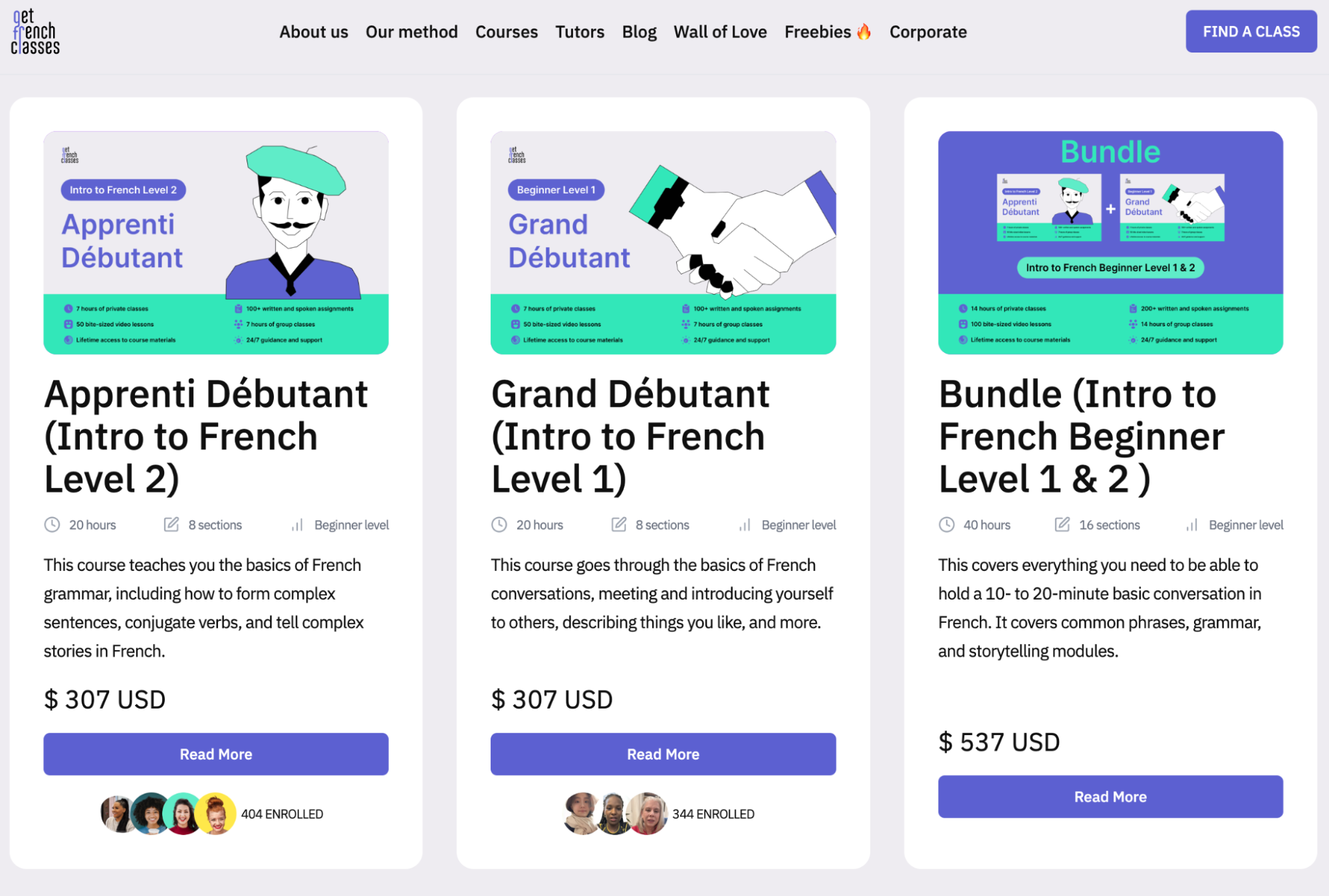
One of the biggest advantages of Get French Classes is its affordability and accessibility.
-
Private French tutors can charge anywhere from $45 to $90 per hour, which can quickly add up to hundreds or even thousands of dollars over the course of your language learning journey.
-
Language immersion trips, while highly effective, are also prohibitively expensive for many learners and require taking significant time off work or school to travel to a French-speaking country.
Get French Classes, on the other hand, offers a comprehensive learning package for just $307.
This includes 50+ video lessons, 100+ assignments, 6 hours of private French classes , 6 hours of group classes, and access to a supportive community of fellow French learners.
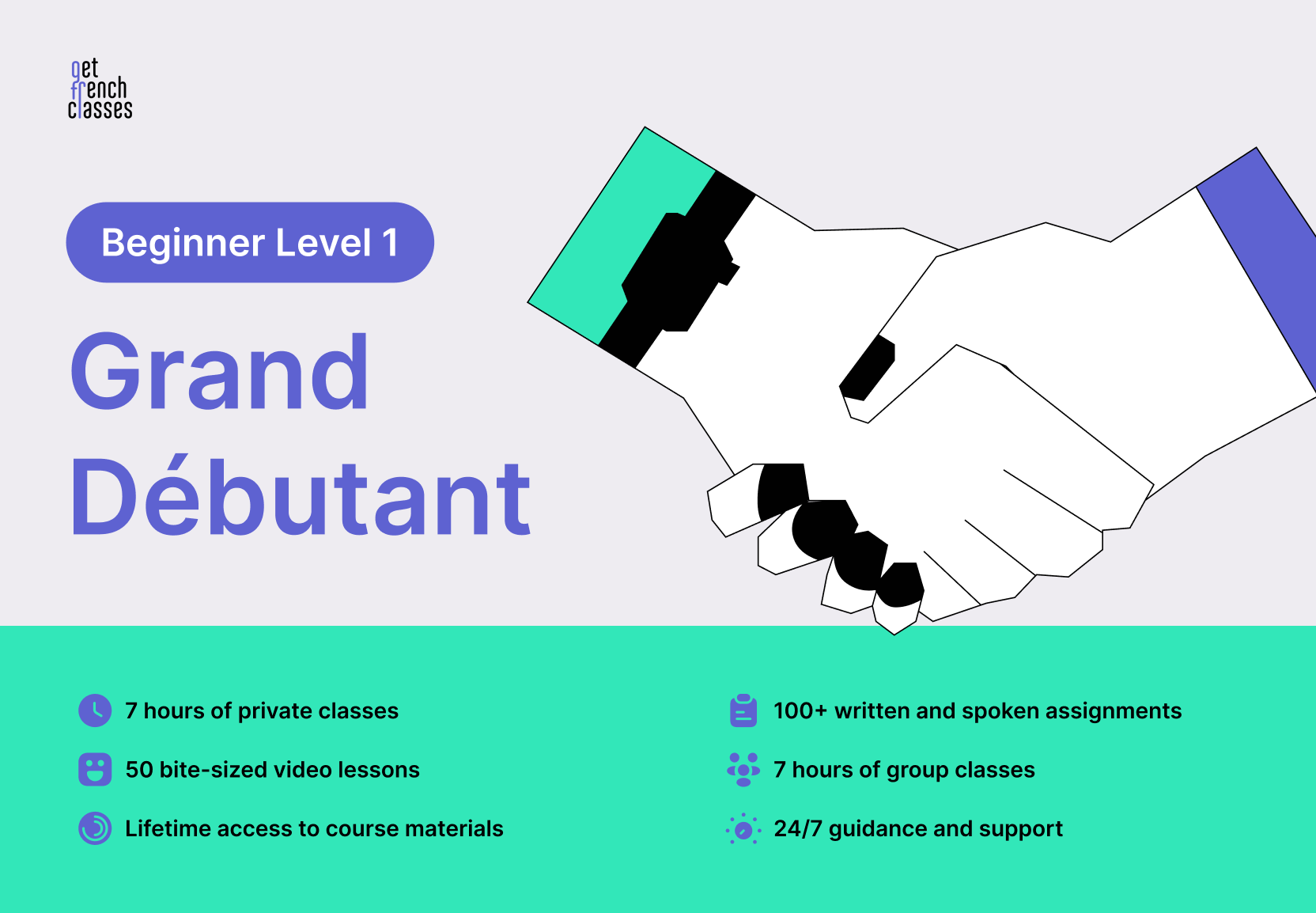
By combining self-paced learning, personalized instruction, and peer practice , Get French Classes provides a cost-effective and flexible alternative to traditional language learning methods.
Another key benefit of Get French Classes is its focus on building daily habits and providing structured learning paths.
Many learners struggle to make consistent progress with apps like Duolingo, which prioritize gamification and vocabulary memorization over authentic communication skills.
With Get French Classes, you'll engage in daily video lessons and assignments that are designed to fit easily into even the busiest schedules.
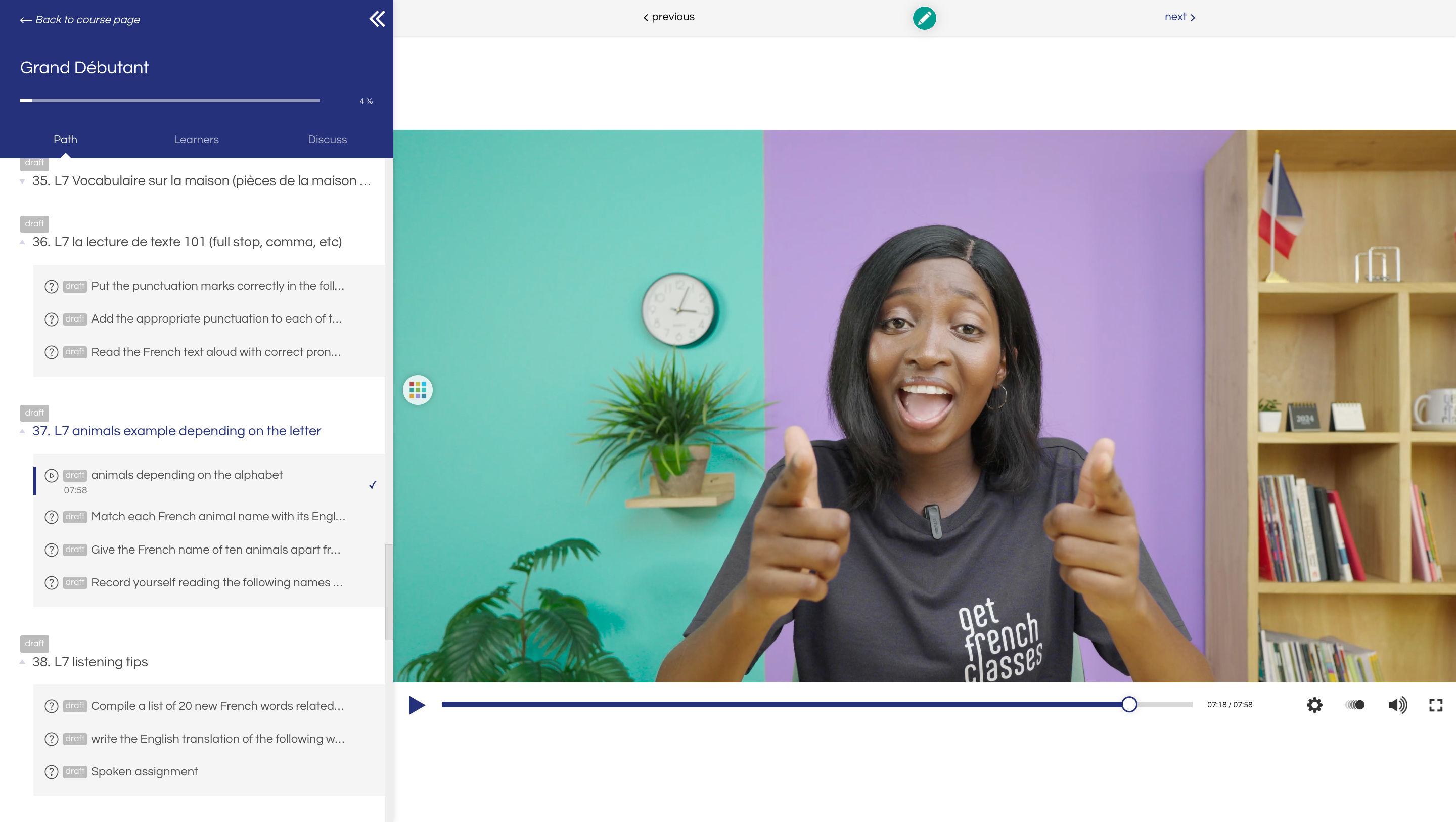
This approach helps you build momentum and stay motivated, while also ensuring that you're constantly challenged and exposed to new aspects of the language.
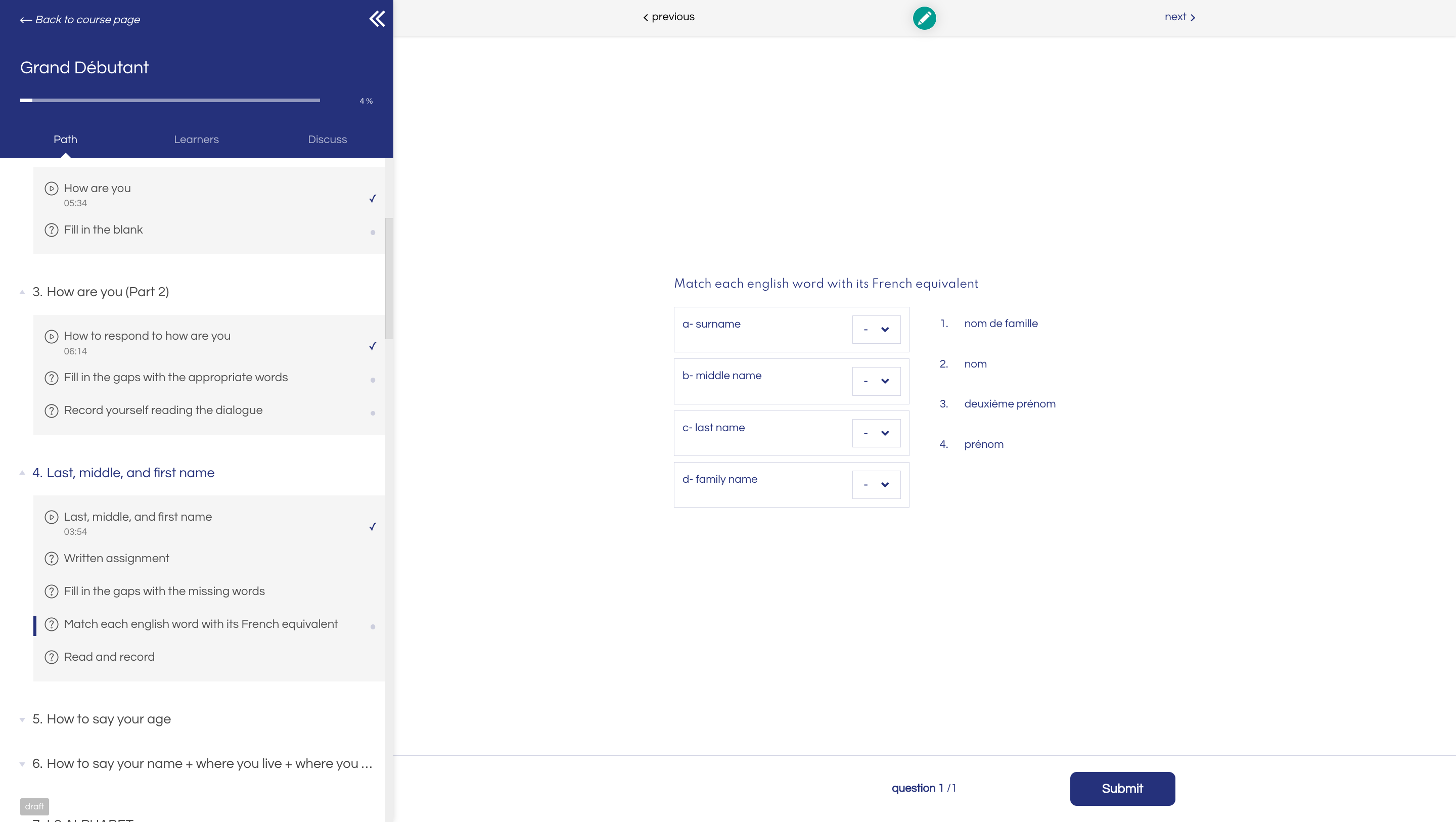
In addition to self-study materials, Get French Classes emphasizes the importance of real-world practice and feedback. Through private classes with experienced tutors , you'll have the opportunity to apply what you've learned in realistic scenarios and receive personalized guidance on your pronunciation, grammar (grammar instruction), and fluency.
Here are some of our tutors:
Our group classes and learning pods provide additional chances to practice your skills with other learners at a similar level, helping you build confidence and overcome the common obstacle of not having someone to speak with regularly.
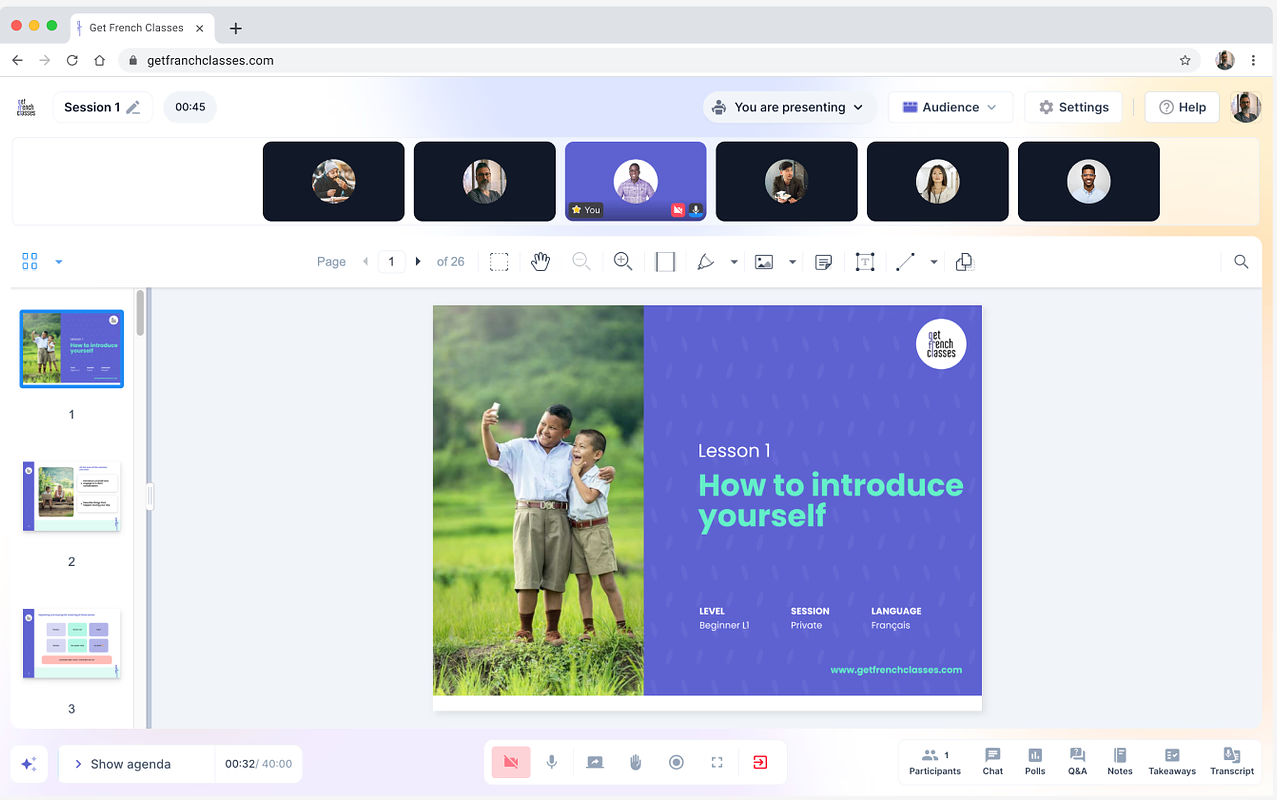
Last but not least, Get French Classes is designed to be truly effective at taking you from a beginner to an intermediate or advanced level of proficiency.
Unlike Duolingo and Babbel, which often leave learners plateaued at a basic level, Get French Classes provides a structured learning path that systematically builds your skills across all key areas of language acquisition: listening, speaking, reading, writing, vocabulary, grammar, and cultural understanding.
By immersing yourself in authentic French content and engaging in regular practice with native speakers and fellow learners, you'll develop the confidence and fluency needed to communicate effectively in real-life situations.
Below is a bird's-eye view of how Get French Classes differs from Duolingo and Babbel.
| Feature | Get French Classes | Babbel | Duolingo |
|---|---|---|---|
| Cost | $307 (one-time per level) | $199 (lifetime) | $168/year (Duolingo Plus) |
| Content quality | Structured learning path, real-life scenarios | Content created by linguists and native speakers | User-generated translations, lack of context |
| Language-learning technology | Video lessons, assignments, and live private and group classes | Speech recognition, personalized review sessions | AI-powered feedback, adaptive difficulty |
| Pedagogical approach | Immersive, communication-focused, habit-building | Traditional methods, grammar-focused | Gamification, vocabulary memorization |
| Effectiveness | Designed to take learners from beginner to intermediate/advanced | Best for beginners, may plateau at basic level | Effective for basic vocabulary, limited for fluency |
| Personalization | Private classes, group practice, and community support | Limited personalization | Adaptive learning, but no human feedback |
| Speaking practice | Private classes, group classes, and learning pods | Limited speaking practice | Speech recognition, but no conversation practice |
| Flexibility | Daily 5-minute video lessons, fits busy schedules | Structured lessons, but less flexibility | Short lessons, but no comprehensive learning path |
| Cultural understanding | Emphasis on real-life situations and authentic content | Some cultural context, but limited | Minimal cultural context or explanations |
| Languages offered | French only | 14 languages | 33 languages |
Here's what some of our learners have to say about our classes:

As a busy mom and professional, learning French has been complicated for me. But since I started learning with Get French Classes, I have seen my French improve FAST. Through the lessons, I not only get to practice every day, but I also have more opportunities than before. I can practice with my advisor, private tutor, and other learners like me.

I chose Get French Classes because their teaching materials and content are incredibly rich, going from everyday expressions to more specialized ones. I also get many opportunities to interact with tutors, and that has a huge impact on my fluency.

What I like the most about the program is that all my tutors are native speakers. They do help me not only understand the French language, but also the culture and the nuances of some words and expressions. And mostly, the live sessions are engaging and fun.
I've tried learning French on my own before, but nothing compares to this program. The combination of video lessons, live tutoring sessions, and group practice made learning French enjoyable and effective.
If you can, don't choose either Duolingo or Babbel
When it comes to learning a language, the ultimate goal should always be achieving fluency—not just racking up XP points or maintaining a streak on an app.
While Babbel may have a slight edge over Duolingo in terms of content quality and structured learning, neither app is truly designed to take you to a high level of proficiency in your target language.
However, if you're specifically learning French and want a comprehensive, effective solution that goes beyond the limitations of Duolingo and Babbel, Get French Classes is your best option.
Our program is tailored to help you:
-
Learn with a structured, immersive curriculum that focuses on real-world communication skills
-
Engage with authentic, context-rich materials that prepare you for real-life scenarios and interactions
-
Practice speaking and build fluency through private classes, group sessions, and peer learning pods
-
Stay motivated and accountable as part of a supportive community of fellow French language learners
-
Fit language learning into your busy schedule with flexible, bite-sized comprehensive lessons and personalized feedback
Of course, learning language isn't rocket science, but there's no doubt that learning a foreign language isn't a piece of cake either. Most language learners constantly learning languages know that well.
Unlike Duolingo and Babbel, which offer a one-size-fits-all approach to language learning, Get French Classes provides a personalized, immersive experience that is designed specifically for French learners who are serious about achieving fluency. Here's what our learners say:

As a busy mom and professional, learning French has been complicated for me. But since I started learning with Get French Classes, I have seen my French improve FAST. Through the lessons, I not only get to practice every day, but I also have more opportunities than before. I can practice with my advisor, private tutor, and other learners like me.

What I like the most about the program is that all my tutors are native speakers. They do help me not only understand the French language, but also the culture and the nuances of some words and expressions. And mostly, the live sessions are engaging and fun.

I chose Get French Classes because their teaching materials and content are incredibly rich, going from everyday expressions to more specialized ones. I also get many opportunities to interact with tutors, and that has a huge impact on my fluency.
I've tried learning French on my own before, but nothing compares to this program. The combination of video lessons, live tutoring sessions, and group practice made learning French enjoyable and effective.
